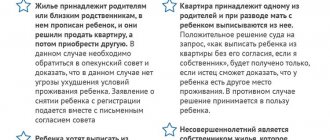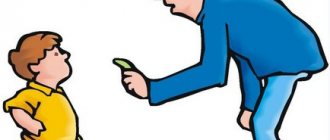Home / Guardianship / Characteristics of the child under guardianship from the class teacher
The modern child spends most of his daily life at school. And sometimes teachers and educators know more about students than busy parents. Especially a lot of attention goes to children left without parental care and under guardianship or guardianship.
Detailed and complete information about a student (character traits, talents, learning abilities and creativity, relationships with peers) can be found out from the teacher or teacher - in the form of characteristics .
In this article we will look at when a characterization of a child under care may be needed, and how to correctly prepare a characterization of schoolchildren of different ages.
Why do you need a reference for a child under your care?
A profile of a child in his care, compiled by a school teacher or educator, may be required in different circumstances:
| In a court | during court proceedings on the deprivation, restriction, restoration of parental rights, determining the child’s place of residence with his mother or father, determining the order of meetings of the child with the parent and other relatives (grandparents, brothers and sisters); |
| At the Juvenile Affairs Inspectorate | if a student commits an offense or crime; |
| In the guardianship and trusteeship authorities | in the course of holding a guardian or trustee accountable for violating the rights of a ward or failure to fulfill duties, when guardianship or trusteeship is canceled, or when the guardian or trustee refuses to perform duties; |
| In social service | during the work of a psychologist or social worker with a child in his care who has experienced trauma, stress, loss, cruelty, and has difficulties in relationships with peers and elders. |
This list of authorities and services where characterization of a child may be required is far from complete.
In addition, characterization may be needed not only for sad and tragic reasons (for example, a crime committed or family discord), but also for solemn and festive occasions (for example, rewarding gifted children, an invitation to a concert, the Kremlin Christmas tree) or regarding the provision of material support from the state or local authorities .
Mechanism for assessing the development of personality traits
In each educational institution, several specialists carry out joint work on the development and education of the ward:
- a class teacher who communicates closely with the child and is constantly in touch with the guardian or trustee;
- a psychologist who diagnoses the internal state of a minor’s personality;
- a social teacher who interacts with the guardianship department and collects information about the child at the request of the department.
It is the psychologist who is responsible for developing the personality qualities of the ward. In the characteristics of the child for the guardianship authorities, he can give a description of his level of development, which is measured by the following indicators:
- performance (with high performance, the student can actively participate in classes in all lessons, with average fatigue is observed, in case of poor performance, he suffers from irritability, drowsiness, lethargy);
- the ability to highlight the main thing in the studied material;
- to what extent he thinks independently;
- ability to work in classes at the required pace;
- manifestation of self-control in the educational process;
- How consciously the child approaches learning activities.
Using these criteria, the psychologist assesses the level of development of the minor, which can be useful in determining the educational route together with the guardianship authority if the child, for objective reasons, does not keep up with the programs.
Recommended reading: How is guardianship different from adoption?
How to write a reference for a child to the guardianship authorities?
Writing a description of a child is not an easy task. This document must be clear and structured in form, while being quite “informal,” complete, detailed, and comprehensive in content.
Form
The specification must be in writing - typed or handwritten.
Basic information about the ward child that must be indicated:
- Title: “Characteristics...”;
- Full name, date of birth, school number and class the child attends,
- place of residence;
- character traits;
- degree of academic performance in core and elective subjects;
- extracurricular interests and additional activities (clubs, sections);
- behavior;
- relationships with peers;
- features of family relationships (cohabitation or separation with mother or father, presence of brothers or sisters, appointment of guardianship or trusteeship);
- the presence or absence of basic things (seasonal clothing and shoes, school supplies), the degree of satisfaction of basic needs (safety, food, warmth, sleep, cleanliness);
- date of;
- signatures.
The description must be signed by the author (teacher or educator) and the school director. The number of the outgoing document must be indicated in the upper corner of the document.
The characteristics are drawn up in 2 copies: the first is sent upon request (for guardianship, court, internal affairs, social services), the second is kept in the student’s personal file.
Content
The characterization should not be “dry” and impartial. It must fully reflect all – positive and negative – features of the child’s personality (character, talents and interests, abilities and motivation to learn, habits, manner of speech and behavior), as well as the characteristics of the child’s relationships ...
- within the family (with parents, guardian or trustee, relatives),
- with peers,
- with officials (teachers, psychologist, director, representatives of the Guardianship Authority, police, court).
When characterizing a child’s personality, use the following criteria:
- motivation for learning, getting an education - strong or weak;
- core and elective subjects with high academic performance;
- core and elective subjects with low performance;
- items of interest
- subjects in which there is a complete lack of interest;
- extracurricular interests;
- stubbornness or flexibility;
- perseverance or restlessness;
- influence or suspiciousness;
- friendliness or isolation;
- restraint or spontaneity;
- organizational skills – strong or weak;
- leadership or followership;
- responsiveness or indifference;
- shyness or boldness;
- respect or insolence;
- independence or need for support, constant control, guidance;
- trusting or hostile relationships in the family;
- aggressiveness or calmness;
- “difficult” or pliable, affectionate disposition;
- high or low self-esteem;
- ambition or modesty;
- satisfied or painful need for acceptance, support, attention from adults and peers;
- close or tense relationships with mother and father, guardian or trustee, relatives.
Additionally, you need to indicate how much the basic (housing, physical) needs of the child are satisfied - safety for life and health, availability of a sleeping place, warmth and cleanliness, availability of food and ready-made food, seasonal clothing and shoes, school supplies.
When compiling a characterization of a child under guardianship, remember that a lot can depend on the completeness and reliability of the comprehensive presentation of information contained in it (for example, registering a child with regulatory, medical, social authorities, removing a child from a dysfunctional and dangerous family, making a decision about a place residence, deprivation of parental rights, appointment of guardianship, removal and holding a guardian or trustee accountable).
Content
A sample reference for a child to the guardianship authorities can be obtained from a specialized department from an employee of this organization. Such a form should include the greatest amount of information about the student, namely:
- Basic information. This item includes the child’s full name, date and year of birth. Here it is necessary to indicate what diagnosis he has (if we are talking about children with disabilities), whether he went to a preschool educational institution and from what year he began attending primary school. If necessary, indicate the classes in which the child managed to study and the years of study.
- Development conditions. Here there is brief information about the health of the parents, which can affect the child (chronic diseases transmitted by inheritance, complications of pregnancy, etc.). The diseases suffered by the baby are indicated.
- Information about the composition of the family, the field of activity of each parent and financial support. The family atmosphere in which the minor grows up must be described. It is necessary to say a few words about the relationships between family members and their attitude towards the child.
This is the basic information present in every autobiography, regardless of the reason for writing it. Below will be presented other points that should also be given attention when drawing up the document.
Physical development
It is necessary to indicate how the child is developing in comparison with peers. If there are any deviations, they should be listed (for example, short stature, obesity). The information in this section can be systematized as follows:
- Motor skills. If a minor has problems associated with motor activity (lethargy, restricted movements), then they must be indicated in the characteristics. If the teacher noticed a clear parallel between the child’s behavior and the atmosphere prevailing in his family, then this should also be reflected in the document.
- Hearing, vision, reaction and other indicators.
- The presence of chronic diseases, how quickly the child gets tired, how he behaves during breaks and physical education lessons.
Cognitive activity
A very important point by which you can draw up a psychological portrait of a minor. It is advisable at this stage to take the help of a professional psychologist. The following aspects are subject to assessment:
- Attention (how steady). Does the baby show persistence when doing a certain activity and how quickly does he get distracted, switching to something else? Features of voluntary and involuntary attention. If a student is a C student, then it is very important to determine the reason for low performance, which may lie either in simple inattention or in a lack of interest in school subjects.
- Perception. It is characterized by the student’s ability to understand the objects around him. The completeness of the information he receives and his awareness of it are assessed. The characteristics of auditory, visual and tactile sensations are determined. Perception of color, shape, size of objects, as well as spatial orientation.
- Memory. It is necessary to evaluate how complete the data memorized by the student is. The degree of meaningfulness with which the child is able to reproduce the received data. How long does it take him to remember factual, numerical, or verbal information? Logical thinking is assessed and the predominant type of memory is identified.
- Speech features. It is assessed how developed the baby's speech is. Attention is paid to rhythm, tempo, possible pronunciation defects, voice features, emotions. It is necessary to assess the child’s vocabulary, ability to conduct dialogue and independent storytelling. Attention should also be paid to written speech - composing essays and performing creative work.
- Thinking. It is indicated how much the child is able to analyze the information received. Can he compare, specify and generalize, find a cause-and-effect relationship, assimilate abstract and general concepts, identify the main idea of the text, drawing appropriate conclusions. It is advisable to describe several objects to him and test his ability to imagine them and identify differences.
Emotional-volitional analysis
It is necessary to determine the degree of excitability of the baby and what type of mood prevails in him. The following is also assessed:
- are there possible outbursts of anger of the ward;
- strong-willed qualities;
- tendency to submit;
- negative manifestations;
- pathological desires;
- degree of friendship and family feelings.
Learning abilities
At this point you need to consider the following:
- Does the child know how to listen and, based on the data obtained in this way, complete tasks?
- Possibility to use teaching aids in work.
- Self-control. Can a child plan his or her own work?
- The ability to assimilate and practically use the acquired knowledge. Can the student give an example of the material he has learned and explain it to another person?
- Attitude to school disciplines. Diligence and motivational characteristics.
- Attitude to punishment and praise, criticism.
Personal qualities
At this point it is very important to indicate the child’s interests, his self-esteem and degree of responsibility. It is necessary to give examples of the student’s behavior at school and outside of it, his attitude towards others (adults and peers) in various life situations. Attention is paid to the child’s place in the team and his ability to adapt to changing conditions.
Conclusions and pedagogical recommendations
Based on all the information presented in the characteristics, it is necessary to draw certain conclusions. It is desirable that this section contains the opinion of not only the teacher, but also the psychologist. If a child has any personal or psychological problems, then you need to attach to the document a specialist’s recommendations for eliminating them. After this, the paper is transferred to the head of the guardianship authorities.
Characteristics of a child may be required in a number of situations, which most often arise against the backdrop of a difficult situation in the child’s family. Being an important document, it must contain objective information about the mental, mental and physical development of the child, identifying all the complex aspects of his life. Therefore, a careful and professional approach to compiling a character reference is necessary, since in most cases it is a decisive document in determining the future fate of a child for whom guardianship can be granted to a third party.
Sample characteristics for a supervised student:
Age differences affect character traits, interests and motivation for learning, and children’s relationships with peers and elders.
In addition, in addition to lessons in basic subjects, children’s time is organized in different ways: children of primary school attend extended day groups, middle school children attend hobby groups and clubs, and senior children attend additional classes in preparation for graduation and admission.
Therefore, the characteristics for children of elementary, middle, and high school are also different.
from elementary school
from high school
from high school
Expert opinion
Dmitry Nosikov
Lawyer. Specialization: family and housing law.
If you need the help of a lawyer in family matters related to the establishment of guardianship and trusteeship, deprivation of a mother or father of parental rights, care and placement of children from disadvantaged families, contact our lawyer for a free consultation.
Attention!
- Due to frequent changes in legislation, information sometimes becomes outdated faster than we can update it on the website.
- All cases are very individual and depend on many factors. Basic information does not guarantee a solution to your specific problems.
That's why FREE expert consultants work for you around the clock!
- via the form (below), or via online chat
- Call the hotline:
- Moscow and the Region
- St. Petersburg and region
- FREE for a lawyer!
By submitting data you agree to the Consent to PD Processing, PD Processing Policy and User Agreement.
Anonymously
Information about you will not be disclosed
Fast
Fill out the form and a lawyer will contact you within 5 minutes
Tell your friends
Rate ( 2 ratings, average: 5.00 out of 5)
Author of the article
Irina Garmash
Family law consultant.
Author's rating
Articles written
612
Approximate characteristics for an orphanage pupil
By counting - mastered ordinal and quantitative, reverse and pairs counting within 10; knows and recognizes numbers, writes them in a notebook; correlates numbers with the number of objects, understands the relationship between numbers within 10; establishes equality and inequality of groups of objects; knows geometric shapes and sees them in the forms of the environment; correctly names the parts of the day, knows the seasons, distinguishes between time concepts; recognizes right and left hands, indicates in words the position of an object in relation to itself; Performs counting operations with numbers using an abacus.
The adaptation period was slow and difficult. A teenager does not have enough knowledge about the world around him. Knows information about himself, his mother’s name and patronymic. Experiences difficulties in establishing simple cause-and-effect relationships between phenomena of reality. General motivation is social. Educational and cognitive motivation is poorly developed.
Attention is unstable, often distracted, attention span is insignificant. He understands educational instructions, but cannot work on them independently. Cannot independently find and correct errors in his work. It is difficult for Sasha to express his elementary judgment, to draw a simple logical conclusion.
Fine motor skills of the hands are well developed, and does not experience difficulties in orienting in notebooks for counting and writing. Follows daily routine.
7th grade student of the Municipal Educational Institution Secondary School in the village of Novy Ural. Egor is a good student. By nature he is calm, friendly, and sometimes reserved. Egor is hardworking and tries to conscientiously fulfill the duties assigned to him. Takes an active part in all events. I enjoy visiting the “Wood Carving” club.
5th grade student of the Municipal Educational Institution Secondary School in the village of New Ural. Yura is a kind, cheerful boy. Relationships with peers are friendly. He carries out instructions from his elders conscientiously. Likes to watch cartoons, play computer and outdoor games.
The purpose of the work of a social teacher in an orphanage is to ensure the social security of each pupil, compliance with all rights and guarantees provided for by the legislation of the Russian Federation and the Khabarovsk Regional Duma for children deprived of parental care.
- The clash of the need to communicate with adults with the frustration of the need for emotional and personal communication
Pedagogical characteristics for a kindergarten student for PMPK
The girl’s adaptation was quick and quite easy. Absent from kindergarten very rarely, mainly for other reasons. The girl goes to kindergarten eagerly, without tears. The girl is always neatly dressed and takes care of her appearance.
Physical development: The girl has difficulty jumping and running. Self-service skills are fully developed. He doesn’t like to dress and undress on his own and is lazy.
The girl is affectionate and kind, she knows the rules of behavior, but if something doesn’t go the way she wants, she can go to a quiet place and sit there until the teachers come to her. She loves to be hugged and shows a friendly attitude towards others.
Reacts adequately to evaluation of completed tasks. If difficulties are encountered, he asks for help and strives to complete the task to the end.
Difficulties are observed in speech development classes. The girl answers questions, but not clearly, cannot clearly tell or retell the fairy tale she has studied, her speech consists of simple sentences.
The girl has difficulty writing stories; cannot identify the first sound in a word; finds it difficult even with the help of an adult to repeat examples of descriptions of the toy; does not accompany its activities with speech. For the holidays, the Girl learns short poems, but she can’t tell them clearly.
The girl also replaces words that are more difficult for her with easier ones: dog - woof-woof, shoes - tops, children - lyali, eat - yum-yum, etc.; looks at the illustrations of children's books with interest, expresses his desire to listen to a certain literary work.
Characteristics of the pupil
Labor skills have been developed. Treats socially useful work conscientiously. Performs all instructions from adults efficiently and independently. The boy has no desire to voluntarily participate in public affairs. Personal and school property is not always treated with care. Possesses sanitary and hygienic skills. He takes care of his appearance.
Characteristics of a 5th grade student raised by a guardian
Masha loves such subjects as history and technology. Mathematics, English, and Russian are more difficult. Spelling skills have not been developed. Particular difficulty arises with tasks. Reading technique is above normal. Masha reads and retells them with pleasure, but she doesn’t always teach poetry. During physical education lessons he often does not comply with the teacher’s requirements, violates discipline, and does not follow safety precautions.
Masha and the guys often have conflicts. He often calls children names, can hit, push, or, in a fit of rage, throw a heavy object at a child without giving a full account of his actions. When injuring children, he does not think about the consequences.
Characteristics of a 5th Grade Student for Guardianship
Makes a lot of mistakes and does not notice them when checking. During a collective discussion and explanation of any tasks, the meaning is not grasped. In his notebooks, the tasks were completed incorrectly, even if the same tasks were completed on the board and checked. Understands the material better only after individual additional lessons. The child’s speech development level does not correspond to the age norm. The student has a delay in the development of phonemic perception: the student cannot analyze the sound and syllabic composition of a word, allowing omissions, rearrangements, and additions of letters. Based on the text he listened to, the student answers questions in monosyllables, cannot form a common sentence, or carry out a consistent, accurate retelling. He has insufficient clarity of speech, a quiet and hesitant voice, low speech activity and a pale emotional coloring of independent statements.
We recommend reading: Dismissal After 10 Years of Service Housing Not Provided
Keeps his own and those lent to him in proper order. Neatly dressed, smart. He is sociable with his peers and prefers quiet games. There are no violations in play activities; the child knows how to obey the general rules of the game. Helps his comrades when asked. Knows how to sympathize.
Approximate characteristics of primary school students
The rest of the time, the grandmother is involved in upbringing, and also supervises ______’s studies and provides financially (food, entertainment - theater, cinema, New Year’s gifts). She is always aware of the events that happened during the current day. She approaches the teacher herself. According to ______, her grandmother teaches her a lot (to sew, read, clean). _____ takes an active part in school life (reads poetry in the evenings) thanks to her grandmother.
The general outlook is very small. A small vocabulary and poor reading do not make it possible to correctly express one’s thoughts in writing and orally. Memory is developed at a mechanical level, it does not possess the techniques of intentional memorization, there is no speed and strength of memorization, therefore, after a few days, without intentional repetition, information is forgotten.









